
Opisthocomidae is a family of birds, the only named family within the order Opisthocomiformes. The only living representative is the hoatzin which lives in the Amazon and the Orinoco delta in South America. Several fossil species have been identified, including one from Africa and one from Europe.

The red-necked spurfowl or red-necked francolin, is a gamebird in the pheasant family Phasianidae that is a resident species in southern Africa.
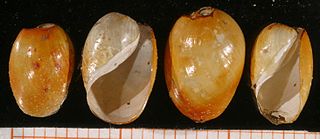
Akera is a marine genus of sea hare in the family Akeridae, known from the late Callovian (Jurassic) to the recent periods.
Philipp Ludwig Statius Müller was a German zoologist.
In zoological nomenclature, author citation is the process in which a person is credited with the creation of the scientific name of a previously unnamed taxon. When citing the author of the scientific name, one must fulfill the formal requirements listed under the International Code of Zoological Nomenclature. According to Article 51.1 of the Code, "The name of the author does not form part of the name of a taxon and its citation is optional, although customary and often advisable." However, recommendation 51A suggests, "The original author and date of a name should be cited at least once in each work dealing with the taxon denoted by that name. This is especially important and has a unique character between homonyms and in identifying species-group names which are not in their native combinations." For the sake of information retrieval, the author citation and year appended to the scientific name, e.g. genus-species-author-year, genus-author-year, family-author-year, etc., is often considered a "de-facto" unique identifier, although this usage may often be imperfect.

The grey-headed kingfisher is a species of kingfisher that has a wide distribution from the Cape Verde Islands off the north-west coast of Africa to Mauritania, Senegal and Gambia, east to Ethiopia, Somalia and southern Arabia and south to South Africa.

Phalangium is a genus of harvestmen that occur mostly in the Old World. The best known species is Phalangium opilio, which is so common in many temperate regions that it is simply called "harvestman".
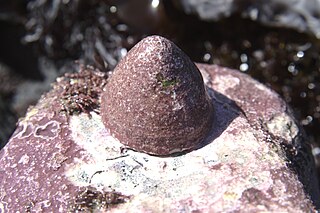
Acmaea is a genus of sea snails, specifically true limpets, marine gastropod mollusks in the family Acmaeidae, one of the families of true limpets.
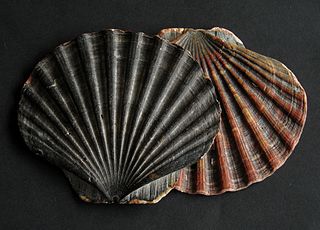
Pecten is a genus of large scallops or saltwater clams, marine bivalve molluscs in the family Pectinidae, the scallops. This is the type genus of the family.
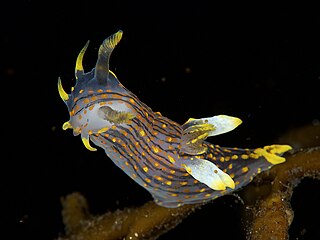
Polycera is a genus of sea slugs, specifically nudibranchs, shell-less marine gastropod molluscs in the family Polyceridae.

Tectura is a genus of small to medium-sized sea snails, true limpets, marine gastropod molluscs in the family Lottiidae. Tectura comes from Latin tegō.

Lepeta is a genus of sea snails, the true limpets, marine gastropod mollusks in the family Lepetidae.

Testudinalia is a genus of sea snails, the true limpets, marine gastropod molluscs in the family Lottiidae.
Tritonium is a genus of sea snails, marine gastropod mollusks in the family Cancellariidae, commonly known as the nutmeg snails.

Spatangus is a genus of heart urchins in the Spatangidae family. The genus is synonymous with the previously recognised genera Prospatangus Lambert, 1902 and Spatagus. There are nine recognised species. The type species is Spatangus purpureus Müller, 1776 by subsequent designation.

Velutina is a genus of small sea snails, marine gastropod mollusks in the family Velutinidae.
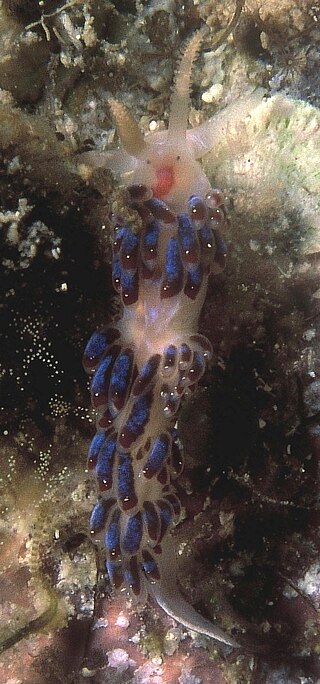
Facelina is a genus of sea slug, an aeolid nudibranch in the family Facelinidae.

Ascidiella aspersa, the European sea squirt, is a species of solitary sea squirts native to the northeastern Atlantic, from the Mediterranean Sea to Norway. They possess oval bodies up to 50 to 130 mm in length. Their branchial siphons are conical and positioned at the top of the body. They possess six to eight lobes. The atrial siphons are located at the upper third of the side of the body and possess six lobes. The body is covered by a firm transparent test that is greyish to brown in color. The test often snag detritus that remain loosely attached to the animal. When expanded, at most 40 tentacles can be observed on the inside surface of the branchial wall. Both the openings of the branchial and atrial siphons possess lighter colored ridges on their rims. They may also be frilled at times. A. aspersa are attached to the substrates by the left side of their bodies. They can be found in dense groups of unfused individuals on hard surfaces like rocks. at depths of up to 90 m (300 ft).

Palliolum is a genus of scallops, marine bivalve molluscs in the family Pectinidae, the scallops.

The broad-billed roller is a member of the roller family of birds which breeds across tropical Africa and Madagascar in all but the driest regions. It is a wet season breeder, which migrates from the northern and southern areas of its range towards the moister equatorial belt in the dry season.

















